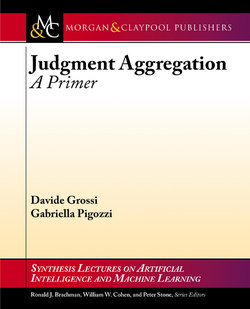Читать книгу Judgment Aggregation - Gabriella Pigozzi - Страница 8
На сайте Литреса книга снята с продажи.
ОглавлениеContents
Preface
Acknowledgments
1 Logic Meets Social Choice Theory
1.1 A Concise History of Social Choice Theory
1.1.1 The Early History
1.1.2 Modern Social Choice Theory
1.2 A New Type of Aggregation
1.2.1 From the Doctrinal Paradox to the Discursive Dilemma
1.2.2 Preference Aggregation and Judgment Aggregation
1.3 Further Topics
2 Basic Concepts
2.1 Preliminaries
2.1.1 Agendas in Propositional Logic
2.1.2 Judgment Sets and Profiles
2.1.3 Aggregation Functions
2.1.4 Examples: Aggregation Rules
2.2 Agenda Conditions
2.2.1 How Interconnected is an Agenda?
2.2.2 Comparing Agenda Conditions
2.3 Aggregation Conditions
2.3.1 How Should an Aggregation Function Behave?
2.3.2 On the ‘Meaning’ of the Aggregation Conditions
2.4 Further Topics
2.4.1 Abstract Aggregation
2.4.2 General Logics
3 Impossibility
3.1 What is the Majority Rule Like?
3.1.1 Properties of Propositionwise Majority
3.1.2 Characterizing Propositionwise Majority
3.2 An Impossibility Theorem
3.2.1 Winning Coalitions
3.2.2 Winning Coalitions as Ultrafilters
3.2.3 Dictators
3.2.4 The Theorem
3.3 (Ultra)filters, Dictators and Oligarchs
3.3.1 Impossibility of Non-Oligarchic Aggregation
3.3.2 Proof: from Ultrafilters to Filters
3.3.3 Impossibility via (Ultra)filters
3.4 Further Topics
3.4.1 Other Impossibility Results
3.4.2 Infinite Agendas and Infinite Voters
3.4.3 Judgment Aggregation vs. Preference Aggregation
4 Coping with Impossibility
4.1 Relaxing Universal Domain
4.1.1 Unidimensional Alignment
4.1.2 Value-Restriction
4.2 Relaxing the Output Conditions
4.2.1 Abstention
4.2.2 Quota Rules
4.3 Relaxing Independence
4.3.1 The Premise-Based Approach
4.3.2 The Sequential Priority Approach
4.3.3 The Distance-Based Rules
4.4 Further Topics
4.4.1 More Domain Restrictions
4.4.2 Dropping Consistency
4.4.3 Other Distance-Based Rules
4.4.4 Judgment Aggregation and Abstract Argumentation
5 Manipulability
5.1 Types of Manipulation
5.1.1 Agenda Manipulation
5.1.2 Vote Manipulation
5.1.3 Manipulability: Definition and Characterization
5.1.4 Sincere and Insincere Manipulation
5.2 Non-Manipulable Aggregation: Impossibility
5.2.1 Auxiliary Results
5.2.2 The Impossibility Theorem
5.3 Further Topics: Manipulation Beyond Impossibility Results
5.3.1 The Possibility of Non-Manipulable Aggregation
5.3.2 Strategy-Proof Judgment Aggregation
5.3.3 Complexity as a Safeguard Against Manipulation
6 Aggregation Rules
6.1 Introduction
6.2 Rules Based on the Majoritarian Judgment Set
6.3 Rules Based on the Weighted Majoritarian Judgment Set
6.4 Rules Based on the Removal or Change of Individual Judgments
6.5 Further Topics
7 Deliberation
7.1 Deliberation and Opinion Pooling
7.1.1 Probabilistic Judgments
7.1.2 A Stochastic Model of Deliberation
7.1.3 Opinion Pooling and Judgment Aggregation
7.2 Deliberation as Judgment Transformation
7.2.1 Deliberation and Voting
7.2.2 Judgment Transformation Functions
7.2.3 Examples of Transformation Functions
7.3 Limits of Judgment Transformation
7.3.1 Conditions on Transformation Functions
7.3.2 An Impossibility Result
7.4 Further Topics and Open Issues
Bibliography
Authors’ Biographies
Index
